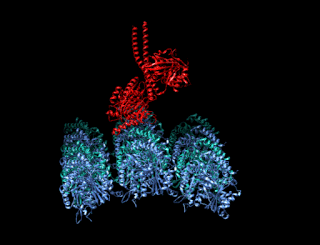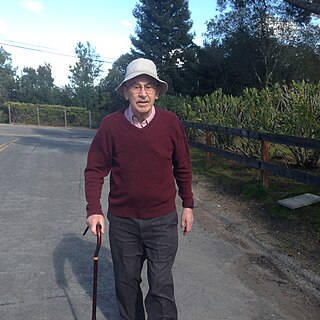Related Research Articles

A kinesin is a protein belonging to a class of motor proteins found in eukaryotic cells.

Dyneins are a family of cytoskeletal motor proteins that move along microtubules in cells. They convert the chemical energy stored in ATP to mechanical work. Dynein transports various cellular cargos, provides forces and displacements important in mitosis, and drives the beat of eukaryotic cilia and flagella. All of these functions rely on dynein's ability to move towards the minus-end of the microtubules, known as retrograde transport; thus, they are called "minus-end directed motors". In contrast, most kinesin motor proteins move toward the microtubules' plus-end, in what is called anterograde transport.

Margaret Belle (Oakley) Dayhoff was an American physical chemist and a pioneer in the field of bioinformatics. Dayhoff was a professor at Georgetown University Medical Center and a noted research biochemist at the National Biomedical Research Foundation, where she pioneered the application of mathematics and computational methods to the field of biochemistry. She dedicated her career to applying the evolving computational technologies to support advances in biology and medicine, most notably the creation of protein and nucleic acid databases and tools to interrogate the databases. She originated one of the first substitution matrices, point accepted mutations (PAM). The one-letter code used for amino acids was developed by her, reflecting an attempt to reduce the size of the data files used to describe amino acid sequences in an era of punch-card computing.

Motor proteins are a class of molecular motors that can move along the cytoplasm of cells. They convert chemical energy into mechanical work by the hydrolysis of ATP. Flagellar rotation, however, is powered by a proton pump.

Eva Nogales is a biophysicist at the Lawrence Berkeley National Laboratory and a professor at the University of California, Berkeley, where she served as head of the Division of Biochemistry, Biophysics and Structural Biology of the Department of Molecular and Cell Biology (2015–2020). She is a Howard Hughes Medical Institute investigator.
Susan G. Ernst is professor emerita at Tufts University known for her work on cell development using sea urchins as a model system. She is an elected fellow of the American Association for the Advancement of Science.

Dynactin subunit 1 is a protein that in humans is encoded by the DCTN1 gene.

Dynactin is a 23 subunit protein complex that acts as a co-factor for the microtubule motor cytoplasmic dynein-1. It is built around a short filament of actin related protein-1 (Arp1).

Anthony Arie Hyman FRS is a British scientist and director at the Max Planck Institute of Molecular Cell Biology and Genetics.
The Margaret Oakley Dayhoff Award from the Biophysical Society in Rockville, Maryland, is given to a woman who "holds very high promise or has achieved prominence while developing the early stages of a career in biophysical research". It is "one of the top national honors" in biophysics. The award was established in 1984 in honor of Margaret Dayhoff, a biophysicist associated with the Biophysical Society and the National Biomedical Research Foundation.
Alex Mogilner is an American professor at the Courant Institute of Mathematical Sciences and the Department of Biology at New York University. His major contribution to science are in the areas of cell motility and division and innovations in cell imaging.

Anna Sergeevna Akhmanova is a Russian-born professor of Cell Biology at Utrecht University in the Netherlands. She is best known for her research regarding microtubules and the proteins, called TIPs, that stabilize one specific end of the tubules. Among the awards she has won, she was one of the recipients of the 2018 Spinoza Prize, the highest honor for Dutch scientists.

Iva Marija Tolić is a Croatian biophysicist, known for her work on the microtubule cytoskeleton and associated motor proteins. She is currently Senior Research Group Leader and professor of Biology at the Ruđer Bošković Institute in Zagreb, Croatia.

Ian Read Gibbons, was a biophysicist and cell biologist. He discovered and named dynein, and demonstrated energy source as ATP is sufficient for dynein to walk on microtubules. In 2017, he and Ronald Vale received the Shaw Prize for their research on microtubule motor proteins.
Rae Marie Robertson-Anderson is an American biophysicist who is Associate Professor at the University of San Diego. She works on soft matter physics and is particularly interested in the transport and molecular mechanics of biopolymer networks. Robertson-Anderson is a member of the Council on Undergraduate Research.
Edwin W. Taylor is an adjunct professor of cell and developmental biology at Northwestern University. He was elected to the National Academy of Sciences in 2001. Taylor received a BA in physics and chemistry from the University of Toronto in 1952; an MSc in physical chemistry from McMaster University in 1955, and a PhD in biophysics from the University of Chicago in 1957. In 2001 Taylor was elected to the National Academy of Scineces in Cellular and Developmental Biology and Biochemistry.
Alice Cheung is an American biochemist who is a Professor of Molecular Biology at the University of Massachusetts Amherst. Her research considers the molecular and cellular biology of polarization. She was elected a Fellow of the American Association for the Advancement of Science in 2020.

Erika L F. Holzbaur is an American biologist who is the William Maul Measey Professor of Physiology at University of Pennsylvania Perelman School of Medicine. Her research considers the dynamics of organelle motility along cytoskeleton of cells. She is particularly interested in the molecular mechanisms that underpin neurodegenerative diseases.
J. Richard McIntosh is a Distinguished Professor Emeritus in Molecular, Cellular, and Developmental Biology at the University of Colorado Boulder. McIntosh first graduated from Harvard with a BA in Physics in 1961, and again with a Ph.D. in Biophysics in 1968. He began his teaching career at Harvard but has spent most of his career at the University of Colorado Boulder. At the University of Colorado Boulder, McIntosh taught biology courses at both the undergraduate and graduate levels. Additionally, he created an undergraduate course in the biology of cancer towards the last several years of his teaching career. McIntosh's research career looks at a variety of things, including different parts of mitosis, microtubules, and motor proteins.
Antonina Roll-Mecak is a Romanian-born American molecular biophysicist. She is currently the Senior Investigator and Chief of the Unit of Cell Biology and Biophysics at the National Institutes of Health. She holds appointments at the National Institute of Neurological Disorders and Stroke; and at the Biochemistry and Biophysics Center of the National Heart, Lung and Blood Institute. Roll-Mecak is known for her work in understanding cytoskeletal regulation, mechanisms of microtubule dynamics and laying the groundwork for deciphering the complexities of the tubulin code. She is also known for her work on microtubule severing enzymes spastin and Katanin.
References
- 1 2 3 "528: Dr. Jennifer Ross: Studying the Physics of How Cells Self-Organize". People Behind the Science Podcast. 2019-11-18. Retrieved 2021-03-27.
- 1 2 "Jenny Ross' Website". web.physics.ucsb.edu. Retrieved 2021-03-27.
- 1 2 "NSF Award Search: Award # 1344203 - INSPIRE Track 1: Condensed Phases and Transitions of Cellular Patterns". www.nsf.gov. Retrieved 2021-03-27.
- 1 2 3 4 "Physicist Jennifer Ross named Cottrell Scholar". Office of News & Media Relations | UMass Amherst. Retrieved 2021-03-27.
- ↑ "Physics Professor Jenny Ross Wins Grant to Study Organization Inside Cell's Space". Office of News & Media Relations | UMass Amherst. Retrieved 2021-03-27.
- ↑ "UMass Amherst physics professor wins grant to study organization inside cell's space". EurekAlert!. Retrieved 2021-03-27.
- ↑ "PI: Jennifer Ross". ross-lab. Retrieved 2021-03-27.
- 1 2 Bernardi, Dan (31 January 2023). "Arts and Sciences Professors Honored by American Association for the Advancement of Science". Syracuse University News . Retrieved 1 February 2023.
- ↑ "The Biophysical Society - Margaret Oakley Dayhoff Award". www.biophysics.org. Retrieved 2021-03-27.
- ↑ Advancement, Research Corporation for Science. "Scialog® – CMC Fellows and Facilitators". Research Corporation for Science Advancement. Retrieved 2021-03-27.
- ↑ "Jenny Ross named Fellow of the American Physical Society | Department of Physics | UMass Amherst". Physics Department at UMass Amherst. Retrieved 2021-03-27.
- ↑ "The Office of Faculty Development Welcomes New Chancellor's Leadership Fellow, Recognizes Inaugural Fellows". Office of News & Media Relations | UMass Amherst. Retrieved 2021-03-27.
- ↑ "Chancellor's Leadership Fellowship | Office of Faculty Development". Office of Faculty Development : UMass Amherst. Retrieved 2021-03-27.
- ↑ "2022 AAAS Fellows". American Association for the Advancement of Science (Press release). October 2022. Retrieved 1 February 2023.
- ↑ "People Behind the Science Podcast - Stories from Scientists about Science, Life, Research, and Science Careers - 528: Studying the Physics of How Cells Self-Organize - Dr. Jennifer Ross on Stitcher". Stitcher. Retrieved 2021-03-27.